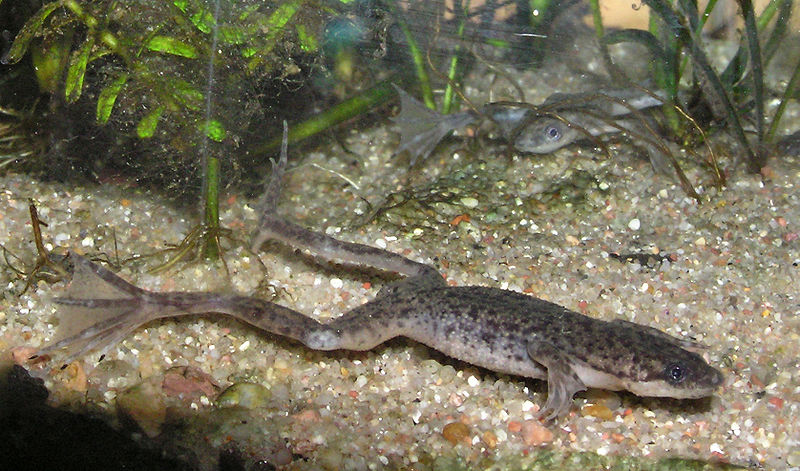The Panamanian golden frog (Atelopus zeteki) is one of the world’s most highly endangered amphibians, but has entered the pet trade from time to time and is sometimes seen in private collections. I’ve had the good fortune of working with these Neo-Tropical gems at the Bronx and Staten Island Zoos, and would like to highlight their amazing natural history and desperate plight here.
Description
 Golden frogs reach a mere 1.4 – 2.5 inches in length, with individuals inhabiting dry forests being 2/3 the size of wet forest dwellers (please see “Habitat”, below).
Golden frogs reach a mere 1.4 – 2.5 inches in length, with individuals inhabiting dry forests being 2/3 the size of wet forest dwellers (please see “Habitat”, below).
Slim and long-legged, golden frogs are clad in bright gold, brilliant to pale yellow, or greenish-yellow. The black markings they sport range from random blotches to small spots, or may be entirely absent. The head is longer than it is wide, and the snout is pointed.
Sub-adult frogs are very different from adults in appearance, being vivid green with black markings. This color scheme provides excellent camouflage among the moss-covered boulders of their streamside habitat.
Most people are surprised to learn that this species is classified in the family Bufonidae, along with the familiar American toad. It usually moves with a peculiar, ambling walk.
Range
Golden frogs are known only from the Cerro Campers-Valle de Anton region of western Panama.
Habitat
Golden frogs are restricted to the margins of swiftly flowing streams on the montane slopes of Panama’s Central Cordillera rainforests and cloud forests, at elevations of 335-1,315 meters above sea level.
There are 2 distinct habitat types, wet forest and dry forest. Animals within wet forest habitats congregate on streamside boulders, to a height of 9 feet above the ground; dry forest frogs forage mainly on the ground. In both habitats, females move into the forest with the approach of the rainy season, while males tend to remain in the territories that they have established along the streams.
Communicating by Sign Language
The Panamanian golden frog has evolved a number of adaptations that allow it to breed in swiftly flowing streams, which are relatively hostile environments for small amphibians.
Males utilize hand waving and foot movements, known as “semaphoring”, in order to advertise their presence to females and to discourage other males. This communication system has apparently evolved in response to the deafening noise of the waterfalls in the streams where these frogs reproduce…vocal signals from such a small animal would be ineffective.
Males that intrude on another’s territory are attacked, and a wrestling bout ensues.
Eggs
A single egg strand, containing 200-650 eggs, is laid by each female. The egg strand is attached to a large rock, which protects it from fast currents. The eggs hatch in 7-10 days.
Tadpoles
The tadpoles are dark with golden flecks and have an adhesive disc on the ventral surface that allows them to cling to rocks in fast-moving streams. They feed by scraping algae and diatoms from the surface of submerged rocks, and congregate at the edges of pools below cascades.
In captivity, tadpoles transform over an unusually variable time period…75-265 days.
Metamorphosis
Newly transformed frogs differ greatly from adults in appearance, being vivid green with black markings. They also differ in behavior – whereas the adults are diurnal and quite bold, young golden frogs hide among moss covered streamside boulders.
It is believed that sub-adult frogs lack the potent skin toxins of the adults, and therefore rely upon camouflage for protection.
Further Reading
You can read about golden frog conservation projects at
http://www.inibico.org/Projects/Atelopusproject/tabid/39/Default.aspx?PageContentID=8.
Image referenced from Wikipedia and originally posted by Jeff Kubina.
 That Reptile Blog – Reptile, Amphibian and Exotic Pet Care and Information
That Reptile Blog – Reptile, Amphibian and Exotic Pet Care and Information

 Native to extreme northeastern Australia, New Guinea, Timor and the Solomon Islands, this striking relative of the White’s treefrog inhabits swamps, rainforests, farms and suburban yards. It is the world’s largest treefrog, reaching a snout-vent length of nearly 6 inches.
Native to extreme northeastern Australia, New Guinea, Timor and the Solomon Islands, this striking relative of the White’s treefrog inhabits swamps, rainforests, farms and suburban yards. It is the world’s largest treefrog, reaching a snout-vent length of nearly 6 inches. Both are members of the frog family Pipidae, a group of 32 species of aquatic, tongue-less and thoroughly engaging creatures. Included the Pipidae is the bizarre, back-brooding Surinam toad (Pipa pipa) and its 5 relatives.
Both are members of the frog family Pipidae, a group of 32 species of aquatic, tongue-less and thoroughly engaging creatures. Included the Pipidae is the bizarre, back-brooding Surinam toad (Pipa pipa) and its 5 relatives. Unfortunately, both are often sold as “oddities” for tropical fish aquariums. This situation rarely works out…African clawed frogs consume all but the largest of fishes, and dwarf frogs are inevitably out-competed for food and perish in short order.
Unfortunately, both are often sold as “oddities” for tropical fish aquariums. This situation rarely works out…African clawed frogs consume all but the largest of fishes, and dwarf frogs are inevitably out-competed for food and perish in short order. Gradually reduce the temperature to 65 F during the night (a basement is ideal) and 68 F during the day (use a small incandescent bulb to raise the temperature) and maintain this schedule for 4 weeks. Thereafter, hold the temperature at 65 F round-the-clock for an additional 2 weeks. The terrarium should be kept in the dark throughout this time, and the frogs should not be fed.
Gradually reduce the temperature to 65 F during the night (a basement is ideal) and 68 F during the day (use a small incandescent bulb to raise the temperature) and maintain this schedule for 4 weeks. Thereafter, hold the temperature at 65 F round-the-clock for an additional 2 weeks. The terrarium should be kept in the dark throughout this time, and the frogs should not be fed.